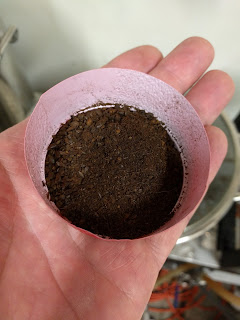I've really been enjoying my Microburst IPAs which are inspired by Noble Ale Works' IPAs. I recently got my hands on some 2016 harvest El Dorado and Azacca hops so I'm doing another variant with these hops plus some 2015 Citra. I'm also planning on splitting the batch and fermenting half with US-05 and half with a special brett blend that I got from Co-Brew, an absolutely awesome homebrew shop located in downtown Denver. Co-Brew had
Inland Island grow up this custom blend to their specs, so I figured I better give it a try. I picked up a vial when we were in Denver visiting friends and this was one of the coolest homebrew shops I've ever seen. Besides having all the latest homebrew gadgets, they also have setups for brew on premises, their own beers on tap to purchase by the glass, and they have their own barrel program in-store...pretty freaking sweet! Besides all that, the owners are really nice people and they love to talk beer. It's worth stopping in if you're in the area.
I also have a new piece of equipment I'm going to try out, a corny keg dry hop filter from
NorCal Brewing Solutions. I'll be using this to dry hop one of the kegs from this batch and see how it does containing hop debris while hopefully infusing some hoppy goodness in the beer. I imagine this filter will be a regular item on their site, but as of the date of this post, it was only available as a pre-order item.
Here's the recipe as I'm making it today.
Expected OG 1.076
~51 IBUs
Est ABV 8.9%
5# 11oz Rahr 2-row
3.5# Avangard Pilsner Malt
1.5# Simpsons Golden Promise Malt
25 grams Carafa III (added before sparge to adjust color)
1.0 # 3oz Corn Sugar (boil)
6ml Hop extract (60 min) ~ 49 IBUs
Wyeast Nutrient
112g Hop blend (1 min) ~ 2 IBUs (52g El Dorado, 52g Azacca, 28g Citra)
US-05
Co-Brew Brett Blend
132g Hop blend (dry hop) (48g El Dorado, 48g Azacca, 48g Citra)
Mash at 150F, 90 minute boil, 60 minute hop stand at 160F, ferment at 64F, dry hop after primary fermentation slows down.
For water profile I'm going with Tasty's water again. To 10 gallons of distilled water I added:
16g Gypsum (CASO4)
7g Epsom salt (MgSO4)
2g Canning salt (NaCl)
1g Calcium Chloride (CaCl2)
Brewing Notes
No real issues except that my gravity was lower than I expected (1.070). Then it dawned on me...I forgot to add the corn sugar. I'll let this beer ferment most of the way through primary, then I'll boil the corn sugar with a little bit of water and dose each fermenter.
Update 11/30/2016
The US-05 half of the batch took off fairly quickly while the Co-brew half lagged behind showing no signs of active fermemtation. I decided 64F was probably a little too cool for the brett blends and brought the fermenter into the house the afternoon of 11/28 to ferment at room temp (about 69-70F this time of year). Within 24 hours it started showing signs of active fermemtation with thin a trace of foam on top and some positive pressure in the airlock. Fermentation is super active this morning.
Update 12/23/2016
The Co-Brew Brett half was kegged yesterday with dry hops in the corny keg dry hop filter. The clean half will go on dry hops today.
Update 1/10/2018
I kegged the clean half of this beer before going on a little trip. I tasted the Brett half before I left and there was quite a bit of hop debris in suspension, but the flavor and aroma where great. I pulled another sample last night and aroma was still great, but the flavor and bitterness seemed to have dropped off a bit. There was also a noticable alcohol flavor. I'm going to put the clean half on tap this week and do some comparisons to see if some of the character is related to the brettanomyces.

























